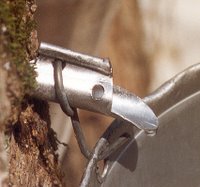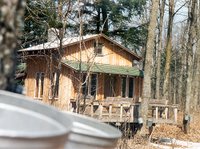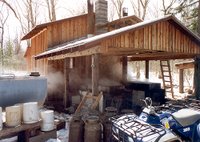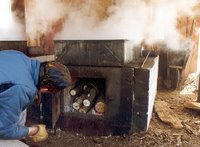Maple syrup

A new post! I have restaurant reports to write up, birthday cakes pictures to post, dog pictures waiting and ready but first let us talk about buckets on trees. Wha? Yep, that is where maple syrup comes from.
 In San Diego seasons barely exist but 2000 miles away in Wisconsin, where I grew up, spring time for some means maple syrup season. Yep, that real from-the-tree stuff. Oh, when you think of real maple syrup you probably think of Vermont and Maine, but northwoods WI makes its own little share of the stuff. When mid-March hits, it’s time to tap the trees (drill a hole, pound in a spout) and hang a bucket to catch it. The sap looks just like water and tastes, as you might expect, slightly sweet.
In San Diego seasons barely exist but 2000 miles away in Wisconsin, where I grew up, spring time for some means maple syrup season. Yep, that real from-the-tree stuff. Oh, when you think of real maple syrup you probably think of Vermont and Maine, but northwoods WI makes its own little share of the stuff. When mid-March hits, it’s time to tap the trees (drill a hole, pound in a spout) and hang a bucket to catch it. The sap looks just like water and tastes, as you might expect, slightly sweet. The maple sap only “runs” in the spring as the thawing temperatures arrive. You need below freezing nights and daytime temps in the upper 30’s and lower 40’s. The sap is collected, boiled down, filtered and bottled. (There is a measuring device that tells you when the syrup has the right sugar content.) Mom made the pancakes and the Schwan’s man delivered the ice cream. (Did you know? Maple syrup is tasty on ice cream!)
The maple sap only “runs” in the spring as the thawing temperatures arrive. You need below freezing nights and daytime temps in the upper 30’s and lower 40’s. The sap is collected, boiled down, filtered and bottled. (There is a measuring device that tells you when the syrup has the right sugar content.) Mom made the pancakes and the Schwan’s man delivered the ice cream. (Did you know? Maple syrup is tasty on ice cream!)It isn’t unusual to drive around the countryside and see buckets (or the more modern bag) hanging from the trees (sugar maple trees only – don’t try to tap a oak tree!) As I recall, as kids, my Dad’s family would make maple syrup with his brother continuing for years. Eventually by the late 1980’s, the next generation, my brothers and I wanted to make syrup – we had the land and the trees (we owned 80+ acres)
 It was a success; a cabin in the woods was built, with an attached cooking shelter and the tradition of sorts continued on. 100 gallons or more would be produced each year, to be sold or given away to friends and family. Our family would be involved, along with a few neighbors. The sap cooking was fairly low tech, over a couple enclosed fire pits, each with a large pan. There are better systems – evaporators and such – but this is a typical small time operation. The sap takes a while to cook down (40 gallon of sap need to cook down to equal one gallon of syrup) so there is plenty of down time. The cabin would be a little retreat, a half mile from the house, near a river (it flooded a time or two in the spring), a place to hang out, play cards, have a beverage or a cook up a steak over one of the grills all while the gallons of sap cooked down.
It was a success; a cabin in the woods was built, with an attached cooking shelter and the tradition of sorts continued on. 100 gallons or more would be produced each year, to be sold or given away to friends and family. Our family would be involved, along with a few neighbors. The sap cooking was fairly low tech, over a couple enclosed fire pits, each with a large pan. There are better systems – evaporators and such – but this is a typical small time operation. The sap takes a while to cook down (40 gallon of sap need to cook down to equal one gallon of syrup) so there is plenty of down time. The cabin would be a little retreat, a half mile from the house, near a river (it flooded a time or two in the spring), a place to hang out, play cards, have a beverage or a cook up a steak over one of the grills all while the gallons of sap cooked down. And so it went for on years. My last year of helping was 2002 and I would kind of miss it each spring. I got the call from my brother that there was a fire on Thursday night. Yep, another year of syrup making was starting. The sap had been collected; wood added and the fire stoked in the afternoon. When the my brother and Dad went down there after supper they could see the glow as soon as then went down the hill to the cabin. The fire department was called – no doubt the fire could be seen for miles – and put out and thankfully no one was hurt…
And so it went for on years. My last year of helping was 2002 and I would kind of miss it each spring. I got the call from my brother that there was a fire on Thursday night. Yep, another year of syrup making was starting. The sap had been collected; wood added and the fire stoked in the afternoon. When the my brother and Dad went down there after supper they could see the glow as soon as then went down the hill to the cabin. The fire department was called – no doubt the fire could be seen for miles – and put out and thankfully no one was hurt…
…but the cabin was gone.

2 Comments:
Oooh Scott - i'm glad no one was hurt. What kind of effort would it take to rebuild?
The old one was built with leftover constuction supplies and lumber milled from my uncle's sawmill - a rebuild will take some insurance money. It might take better system to make the syrup (an evaporator unit) and haul the sap up to an area closer to the house (and running water and power). Still a cabin in the woods is always a possibility - rebuilding was talked about even as the fire was burning.
Post a Comment
<< Home